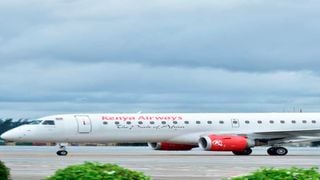
A Kenya Airways plane.
| File | Kevin Odit | Nation Media GroupBusiness
Premium
Job cuts loom in KQ changes after Sh26bn Treasury bailout
Struggling national carrier Kenya Airways (KQ) is set for a fresh round of job cuts in a major restructuring plan linked to the Sh26.6 billion Treasury bailout that seeks to save it from collapse.
The airline will have to drop some of its routes, rationalise the frequencies of flights, operate a smaller fleet and maintain a lean workforce.
KQ chief executive Allan Kilavuka said the funds would strengthen their cash flow and speed up reforms on its route network, fleet and operations.
“It’s, however, important to mention that the financial support from government is also conditional on Kenya Airways and all other stakeholders, such as suppliers, bankers, shareholders and employees adhering to the agreed reforms to support the turnaround,” he said in a letter to employees.
Restructuring
“While the good news is that we have already taken some measures, including staff rationalisation and cost containment measures, we need to up the momentum for the next phase to ensure that the future of pour airline is guaranteed,” he added.
Mr Kilavuka said the restructuring will be guided by a US-based consultancy firm, Seabury Group.
“Seabury will conduct a comprehensive assessment of all aspects of the business and business plans, support leadership in developing a comprehensive restructuring plan covering the network, fleet and required resources and implement the restructuring plan” he said.
Seabury has over the years been appointed by several airlines around the world, including India’s Jet Airways, German air Berlin Air and Norwegian Air Shuttle to advise on cutting losses, revenue growth, and debt restructure.
The Treasury sought to offer Kenya Airways Sh53.4 billion in direct budget support in the fiscal year that ends in June 2022 as well as the subsequent one, making it the largest corporate bailout.
The government is the largest shareholder in KQ with a 48.7 per cent equity share and its exposure to the airline also includes Sh84.81 billion of guarantees to creditors.
KQ has a fleet of 36 aircraft, 19 of which it wholly owns while the rest are leased. Embraer makes up the bulk of its fleet at 15. The airline flies to 56 destinations worldwide – 46 of which are in Africa.
The airline closed 2020 with a workforce of 3,652, having lost about 1,123 employees. Half of the airline staff left through resignations or voluntary early retirements.
Performance tracker
In a strategy aimed at safeguarding the success of the reforms at KQ, the Treasury said the airline’s board of directors would be placed on a performance tracker.
“This will involve implementing a tracker to monitor key actions and milestones in the restructuring process, such as trimming the network, rationalising frequencies and the fleet and addressing the high-cost structure, including the salary or wage bill with a clear measuring system,” Treasury Cabinet Secretary Ukur Yatani said in a report to the International Monetary Fund(IMF) last year.
Owing to its severe cash flow problems over the past three years, KQ has not been able to pay lessors and creditors’ due invoices, resulting in significant outstanding obligations.
The company had to negotiate moratoriums and waivers with lenders and lessors and has been dependent on cash injections from the budget. Even before the pandemic, this was negatively impacting KQ’s operations.
The airline posted a Sh11.49 billion net loss in the six months that ended in June — a 19.8 percent cut from the Sh14.33 billion loss it incurred in the preceding period. This took its accumulated losses over the years to above Sh127 billion.
Liabilities outstripped assets
KQ’s liabilities outstripped assets by Sh73.85 billion as at the end of June compared with Sh64.16 billion in June last year, keeping it technically insolvent.
Accumulated losses and revenue dip caused the company to breach the terms set by global financiers, underlining the airline’s debt distress.
KQ was privatised 24 years ago but sank into debt and losses in 2014 after a failed expansion drive, costly purchase of aircraft, and a slump in travellers after a major terror attack.





